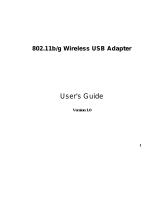
infrastructure mode.
Note: This field shows up to 15 characters although the name of the
access point may be longer.
Associated AP IP Address - The IP address of the access point to which
your client adapter is associated. It is shown only if the client adapter is in
infrastructure mode.
Associated AP MAC Address - The MAC address of the access point to
which your client adapter is associated. It is shown only if the client adapter
is in infrastructure mode.
Power Save Mode - The client adapter's current power consumption
setting. (CAM (Constantly Awake Mode), Max PSP (Max Power Saving), or
Fast PSP (Power Save Mode))
Current Power Level - The power level at which your client adapter is
currently transmitting. The maximum level is dependent upon the radio
band used and your country's regulatory agency.
(10, 20, 30, 50, 63, or 100 mW (802.11b/g band),
10, 13, 20, 25, or 40 mW (802.11a band))
Available Power Levels - The power levels at which your client adapter
is capable of transmitting. The maximum level is dependent upon the radio
band used and your country's regulatory agency.
(10, 13, 20, 25, or 40 mW (802.11a); 10, 20, 30, 50, 63, or 100 mW
(802.11b/g))
Current Signal Strength - The signal strength for all received packets.
The higher the value, the stronger the signal. (0 to 100% or 0 to -100 dBm)
Current Signal Quality - The signal quality for all received packets. The
higher the value, the clearer the signal. (0 to 100%)
Current Noise Level - The level of background radio frequency energy in
the current radio band. The lower the value, the less background noise
present. (0 to -100 dBm)
Up Time - The amount of time (in hours:minutes:seconds) since the client
adapter has been receiving power. If the adapter has been running for
more than 24 hours, the time is displayed in days, hours:minutes:seconds.
802.11b Preamble - Indicates whether your client adapter is using only
long radio headers or short and long radio headers. (Short & Long or Long
Only)
Current Link Speed - The rate at which your client adapter is currently
transmitting data packets. (1, 2, 5.5, 6, 9, 11, 12, 18, 24, 36, 48, or 54
14





















